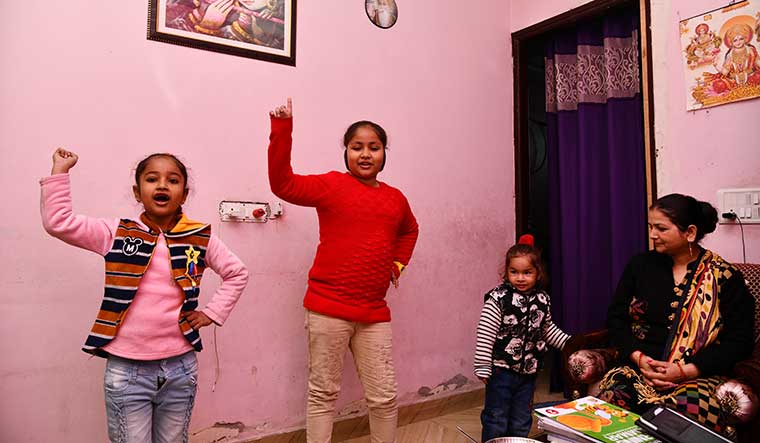FROM A DISTANCE, it seems like Rajkishori Devi is staring at a wall, waiting her turn at a mohalla clinic in south Delhi’s Panchsheel Vihar. The mohalla clinics are a network of 400 primary health centres set up by the Aam Aadmi Party government to offer essential services free of cost in Delhi’s low-income neighbourhoods.
The wall facing the 60-year-old Rajkishori is plastered with a message against female infanticide. On closer inspection, it becomes clear that Rajkishori is staring blankly into space. “I cannot hear anything. My eardrums got ruptured when my son bashed me up,” she says, almost matter-of-factly. She has been visiting the clinic for four years to treat a thyroid condition. On this day, she is accompanied by her daughter Anu Jaiswal to get medicines for a shooting pain in her abdomen. “She now needs to go to the nearest government hospital for surgery,” says Anu.
As Delhi goes to polls on February 8, welfare measures like the mohalla clinics could play a key role in influencing voters’ choice. After an abysmal showing in the 2019 Lok Sabha elections, Chief Minister Arvind Kejriwal hopes that the AAP’s achievements in three key sectors—health, education and electricity—will help it retain power. And, it has lined up even more freebies: CCTVs and Wi-Fi hotspots across the metropolis, free bus and metro rides for women and pilgrimage schemes for senior citizens. The AAP government also offers full waiver on electricity bills to households consuming up to 200 units and 50 per cent subsidy to those consuming between 201 and 400 units. But what do beneficiaries make of such unprecedented subsidies?
Alok Mishra, who lives in a middle-class colony in Rohini in northwest Delhi, would never have thought of sending his daughters to a government school, although he is the only earning member in his family. “I went to a government school. The toilets used to stink. There were hardly any teachers and up to 90 students would be packed in a single class,” says Mishra. But the AAP’s education revolution has convinced him to pull out his six-year-old daughter Shagun from a private school and enrol her in a government school. He is saving at least Rs8,000 a month in school fees. The new school has better infrastructure, a student-teacher ratio of 1:25 and more invested, well-trained teachers. “Now my daughter takes an active interest in her schoolwork. Previously, I was not sure whether she was learning anything,” he says.
The education budget of the AAP government has gone up consistently over the past five years, touching Rs13,997 crore in 2018-19. It added 20,000 new classrooms and improved the student-classroom ratio from 1:66 to 1:45. The results are already showing. In the ‘Indian School Ranking 2019’ survey conducted by an education portal, Rajkiya Pratibha Vikas Vidyalaya, located in Sector 10, Dwarka, was ranked first, with two more government schools figuring in the top 10 list.
Also read
- Delhi Assembly: AAP chooses Atishi as opposition leader, becomes first woman to hold the post
- Rekha Gupta sworn in as Delhi CM, meet the new cabinet
- Delhi Assembly Poll Results 2025: Failed in ‘Agni Pariksha’? BJP’s Parvesh Verma defeats AAP supremo Arvind Kejriwal
- BJP waived off debt worth Rs 10 lakh crore of its corporate ‘friends’, AAP spending on people: Kejriwal
- Amid Delhi Assembly polls, Pakistani Hindu refugees live between hope and hardship
- Delhi Assembly polls: Kejriwal promises free power, water schemes for tenants; police stop screening of AAP documentary
- ‘Dragging its feet’: Delhi HC slams AAP govt for delaying tabling CAG reports in assembly
- Delhi elections: Cash transfer schemes for women become a major poll plank
While education, health care and electricity have been the AAP’s priorities, the Narendra Modi-led Union government is going ahead with offering ownership rights to individual households in nearly 1,700 unauthorised colonies. Earlier this month, Union Minister for Housing and Urban Affairs Hardeep Singh Puri handed over registry papers and conveyance deeds of houses to 20 residents from two unauthorised colonies in Rohini under the PM-UDAY (Unauthorised Colonies in Delhi Awas Adhikar Yojna).
Pinki Sharma from Suraj Park in Rohini is the first beneficiary of the new scheme. Her house is located in the Rohini assembly constituency, represented by Vijender Gupta of the BJP. Pinki’s husband, Parveen, thanked Gupta for helping his family secure ownership rights for the house. “Usually, the paperwork takes 180 days. Initially, a Delhi Development Authority official said I would have to shell out Rs50,000. But then it was all sorted out. They said they needed to show at least 20 successful cases because of the elections,” says Parveen, a businessman. He is, however, not happy about the freebies being offered by the AAP government, although he himself saved nearly Rs22 lakh in stamp duty under the regularisation scheme. “If the government does not take money from us, how will it serve the next generation? I can pay for my 200 units of electricity. It stings my conscience that I am stealing from the government,” says Parveen.
Voting patterns in BJP strongholds are, however, a maze of contradictions, because access to basic civic amenities seems to be the deciding factor in assembly elections. Rakesh Raut, a 24-year-old paramedical student from Suraj Park, is a supporter of the Modi government. But he says it was the Sheila Dikshit government which gave his colony better roads, sewage systems and clean water. This time, he feels that the AAP is better placed to provide civic amenities. “Look, I like the BJP at the Centre,” says Raut. “But for the state, I would stick with Kejriwal.”



